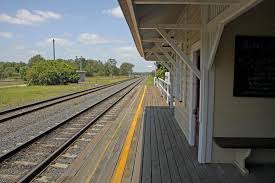Home » America Travel News » Texas Takes a Giant Leap: How the New Austin-San Antonio Rail and CapMetro’s Bold Plan Will Revolutionize Transportation in the US
Published on
October 23, 2025
CapMetro has announced its vision for the future of public transportation in Central Texas with the approval of Transit Plan 2035, a comprehensive roadmap designed to guide the region’s transit growth over the next decade and beyond. The plan outlines strategic changes aimed at improving bus routes, rail systems, and regional connectivity, all while preparing for the growing population and increasing demand for efficient, sustainable transportation solutions. This ambitious initiative is set to transform Austin’s transit system, and with it, the broader Central Texas region, making it more connected, accessible, and efficient.
A Vision for Central Texas’ Transportation Future
CapMetro’s Transit Plan 2035 was approved by the CapMetro Board of Directors on October 20, 2025, marking a pivotal moment in the development of Central Texas’s transportation infrastructure. Designed with community input from over 10,000 residents, this plan reflects the evolving needs of the region’s growing population and aims to provide more reliable, accessible, and sustainable transit options.
This new initiative is focused on long-term solutions for improving the current transit system, addressing both present and future needs. The plan is based on data-informed decisions, ensuring that each phase of implementation aligns with current travel patterns while preparing for the future of transportation, including the integration of Austin Light Rail and regional rail expansion. The plan will be implemented in phases, with key improvements expected to unfold over the next five to ten years.
Focus on Austin-San Antonio Commuter Rail: A Step Toward Regional Connectivity
In addition to the broader CapMetro improvements, another significant initiative is the proposed Austin-San Antonio commuter rail, which is currently being studied for feasibility by HNTB Corporation. This proposed commuter rail, intended to link Austin and San Antonio, is seen as a crucial development for regional connectivity. The study, supported by a $124,953.50 contract with Travis County, aims to explore the viability of connecting these two major cities via commuter rail, making it easier for residents and visitors to travel between Austin and San Antonio.
This rail service would span 80-90 miles, running from State Highway 130 near Austin-Bergstrom International Airport to Interstate 10 in San Antonio. The potential for this project is substantial, especially as the population along the Interstate 35 corridor is expected to grow significantly in the coming years, from 4.5 million people currently to 6-7 million by 2030. The feasibility study is expected to be completed by the summer of 2026, with potential further collaboration from other counties and corporations to secure additional funding if the project progresses.
Enhancing Existing Infrastructure and Expanding Service
The Transit Plan 2035 also highlights the ongoing improvements to existing services within CapMetro’s network. Key components of the plan include the improvement of bus routes, the extension of rail services, and the creation of new Pickup Zones to increase service availability and efficiency. The plan also outlines expanded regional connectivity, allowing for easier and more frequent travel between Austin and surrounding communities.
Notable enhancements in the first five years include the full implementation of the Rapid 800 and 837 bus routes, improvements to rail stations, and extended operational hours. Longer-term goals include further integration with Austin Light Rail, the creation of additional Pickup Zones, and more extensive connections to outlying regions. These changes will improve both commuter convenience and overall transit accessibility.
The Role of Community Engagement in Shaping the Plan
Community engagement has been a key aspect of Transit Plan 2035. CapMetro has actively involved over 10,000 residents in the development of the plan through surveys, open houses, pop-up events, and digital platforms. This feedback has directly influenced key decisions regarding the types of service improvements and the areas of the city most in need of better transit options. The collaborative process ensures that the plan reflects real-world needs and community priorities, rather than being a top-down initiative.
Dottie Watkins, President and CEO of CapMetro, emphasized that the plan’s success is rooted in the active participation of the region’s residents, whose input has shaped nearly 40% of the final plan. This focus on community collaboration ensures that the plan remains relevant, effective, and capable of addressing the evolving transportation needs of the region.
Preparing for Future Growth and Sustainability
As Central Texas continues to experience rapid growth, particularly in the Austin metropolitan area, the need for sustainable public transit solutions becomes even more urgent. Transit Plan 2035 aims to meet these needs by improving service quality and reliability, making public transportation a viable alternative for residents and visitors alike. As the region anticipates continued population growth, these improvements will play a crucial role in addressing congestion and reducing the region’s carbon footprint.
The plan’s focus on sustainability is reflected in its commitment to eco-friendly transport solutions, such as electric buses and light rail systems, which will help reduce the environmental impact of the city’s growing transportation network. CapMetro’s work in expanding regional rail options and integrating them with existing services is also part of the broader goal of promoting sustainable growth and green travel.
The Future of Central Texas Transportation
Looking ahead, CapMetro’s Transit Plan 2035 represents a bold vision for the future of Central Texas’ transportation system. The plan aims to integrate innovative technologies, expand regional connectivity, and provide sustainable solutions to meet the transportation needs of a rapidly growing population. Through its phased implementation, this comprehensive initiative promises to improve the commute and travel experience for all residents and visitors, making public transit a more reliable and accessible option for everyone.
With significant investments in infrastructure and community-driven development, CapMetro is poised to transform Austin and the surrounding region into a more connected, efficient, and sustainable area for both residents and tourists. As the Austin-San Antonio commuter rail study progresses and Transit Plan 2035 begins its implementation, the future of Central Texas transportation looks brighter than ever.

